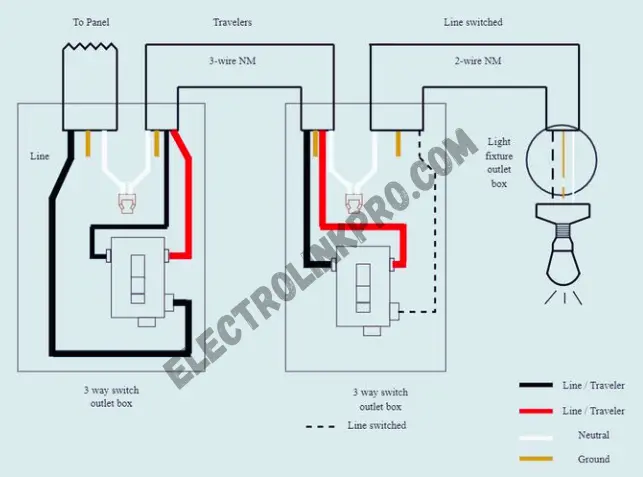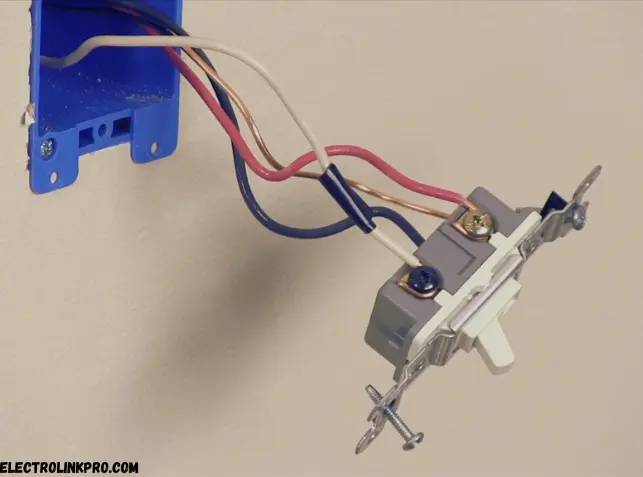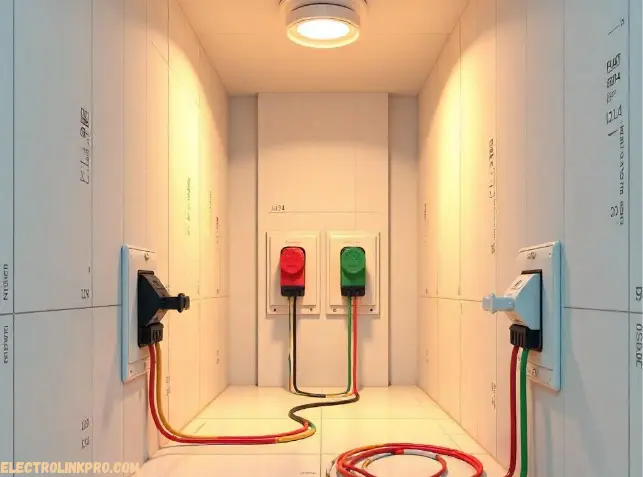Installing a 3 way switch wiring diagram correctly ensures seamless control of lights from two locations. Whether you’re upgrading your home lighting or troubleshooting an existing setup, this guide covers everything—from wiring basics to advanced configurations—with clear diagrams and expert tips.
🔧 Understanding 3 Way Switch Wiring Basics
A 3 way switch wiring diagram allows control of a single light from two different switches, commonly used in stairways, hallways, and large rooms. Unlike a standard single-pole switch, a 3 way switch has three terminals:
- Common Terminal (COM) – Connects to the power source or light fixture.
- Traveler Terminals (Brass Screws) – Carry current between switches.
🔌 Key Components in a 3 Way Switch Wiring Diagram
| Component | Function |
|---|---|
| 3 Way Switch | Allows control from two locations |
| 14/3 or 12/3 NM Cable | Contains black (hot), red (traveler), white (neutral), and ground wires |
| Light Fixture | The load being controlled |
| Electrical Box | Houses wiring connections |

1️⃣ Power Off & Safety First
- Turn off the circuit breaker.
- Verify power is off using a voltage tester.
2️⃣ Identify Wires
- Black (Hot Wire) – Carries live current.
- Red (Traveler Wire) – Connects between switches.
- White (Neutral Wire) – Completes the circuit.
- Ground (Bare Copper) – Safety grounding.
3️⃣ Wiring the First 3 Way Switch
- Connect the black (hot) wire to the common terminal (black screw).
- Attach the red and black traveler wires to the brass screws.
- Secure the ground wire to the green screw.
4️⃣ Wiring the Second 3 Way Switch
- Link the red and black traveler wires to the brass screws.
- Connect the black wire (to light) to the common terminal.
- Ground the switch properly.

5️⃣ Connecting the Light Fixture
- The black wire from the light connects to the second switch’s common terminal.
- The white neutral wire ties into the circuit’s neutral bundle.
📊 3 Way Switch Wiring Diagram (Visual Reference)
| Wire Color | Connection Point |
|---|---|
| Black (Hot) | Common Terminal (1st Switch) |
| Red & Black (Travelers) | Brass Terminals (Both Switches) |
| White (Neutral) | Light Fixture Neutral |
| Ground | Green Screw / Grounding Wire |
🚨 Common Mistakes & Troubleshooting
❌ Incorrect Traveler Wire Connections
- Ensure red and black travelers are on brass screws, not the common terminal.
🔌 No Power to Light
- Check if the common terminal is properly connected.
- Verify all wire nuts are secure.
⚡ Flickering Lights
- Loose connections cause intermittent power—tighten all terminals.
🔄 Switches Not Working Properly
- If one switch fails, recheck traveler wire placements.

🎯Conclusion:
Installing a 3 way switch wiring diagram is an essential skill for homeowners, electricians, and DIY enthusiasts who want flexible lighting control from multiple locations. This guide has provided a step-by-step breakdown, ensuring you understand the wiring process, necessary tools, and common troubleshooting techniques.
🔄 Why Proper 3 Way Switch Wiring Matters
- Convenience & Functionality – Control lights from two different switches (e.g., stairways, hallways, large rooms).
- Safety Compliance – Correct wiring prevents electrical hazards like short circuits or overheating.
- Energy Efficiency – Properly wired switches ensure smooth operation, reducing wear on bulbs and fixtures.
📌 Key Takeaways from This Guide
✅ Terminal Identification – Know the common (COM) and traveler terminals to avoid miswiring.
✅ Correct Wire Connections – Always match:
- Black (hot) → Common terminal
- Red & Black travelers → Brass screws
- White (neutral) → Light fixture
- Ground → Green screw
✅ Testing & Troubleshooting – Use a voltage tester before working and check connections if switches malfunction.
⚠️ Avoid These Common Mistakes
❌ Mixing up traveler and common wires → Causes switches to work incorrectly.
❌ Skipping the ground wire → Creates a safety hazard.
❌ Using incorrect cable (e.g., 14/2 instead of 14/3) → Prevents proper 3-way functionality.
🔧 When to Call a Professional
While DIY installation is possible, consult a licensed electrician if:
The wiring setup is older (e.g., knob-and-tube).
The circuit lacks a neutral wire.
You encounter frequent tripping breakers or flickering lights.
❓ Frequently Asked Questions (FAQs)
1. Can I use a 3 way switch as a single pole?
✅ Yes, but only one traveler terminal will be used—cap the unused wire.
2. Why does my 3 way switch only work one way?
🔧 Check if traveler wires are reversed—swap them at one switch.
3. What’s the difference between 2 way and 3 way switches?
🔄 A 2 way switch is single-pole (one location), while a 3 way switch controls lights from two locations.
4. Can I install a dimmer on a 3 way switch?
💡 Yes, but use a 3 way compatible dimmer and follow manufacturer instructions.
5. Why is my 3 way switch buzzing?
⚡ Faulty wiring or incompatible bulb—check connections and bulb type.